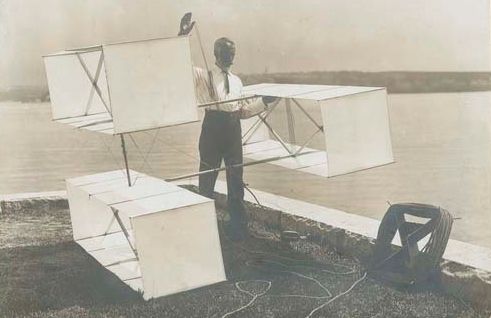
Aviation pioneer Lawrence Hargrave and his three box kite
* Part II in a series of articles on Australia’s entrepreneurial role in the emerging drone industry.1
HISTORY OF AUSTRALIAN AVIATION INNOVATION
Cultivation of an entrepreneurial spirit may in part be attributed to Australia’s geographical reality -- physical isolation by sea and a vast interior. Long distances made it difficult to access to basic services and provided Australian settlers with the incentive to innovate in the transportation industry. Until the end of World War II, Australia was a global leader in flight. From the invention of the box kite in 1893 to drone long distance flight in 1988, Australia has achieved major milestones in the development of aviation technology.
Early Development of Powered Flight
In 1893, Lawrence Hargrave, an Australian engineer, inventor and aeronautical pioneer, invented the box kite, a device that substantially improved the lift-to-drag ratio of early gliders. Hargrave’s subsequent experiments established the box kite as a stable aerial platform, an essential contribution to the development of powered flight.
The First in “Safety First”
Walter Oswald Watt was an Australian aviator and businessman. After retiring from the military and becoming President of the New South Wales section of the Australian Aero Club in 1919, he lobbied politicians for improved civil aviation safety measures. This included Australia’s “Safety First” campaign, which resulted in several Acts of Parliament acknowledging the importance of improved civil aviation standards.
Heroic Age of Aviation
The early 1920s through the early 1930s have been called the heroic age of Australian aviation. Sponsors of ground-breaking flights offered sizeable monetary rewards the winning pilots often used to fund airlines or more flights. Australian pilots typically specialised in taking the longest and most hazardous flights in the world, and many, including Sir Ross Smith, Sir Charles Kingsford Smith and Amy Johnson, set flight records before losing their lives to plane crashes.
In 1944, Norman Rodoni, a Sydney Flight Officer Checker, invented the “Rodoniscope”, a computational device which accurately predicted when faster planes travelling in the same trunk air routes would pass a slower aircraft.
In the mid-1950s, David Warren, a research scientist at the Aeronautical Research Laboratory (ARL) in Melbourne, invented the world’s first flight recorder. He had been investigating the mysterious crash of the Comet, the world’s first jet-powered commercial aircraft. Warren recalled seeing the world’s first miniature recorder at a local trade fair and was inspired to invent something similar. Today, the “black box” voice and instrument data recorder is used in every commercial plane in the world.
Development of Unmanned Aircraft
In the 1950s, the Australia Government developed a jet-powered unmanned aircraft, the Jindivik, which served as a target drone until 1997.
In 1988, the Australian-built Aerosonde “Laima” was the first unmanned aerial vehicle (“UAV”, commonly referred to as a drone) to travel across the Atlantic Ocean.
Australia Pioneers the World’s First Drone Regulations
Seen as one of the world’s fastest growing tech industries, drone innovation has been called “revolutionary.” Many esteemed business analysts liken it to the evolution of the Internet which took root in the 1990s.
In 2002, Australia’s Civil Aviation Safety Authority (CASA) enacted the world’s first unmanned aircraft and safety regulations. The regulations appear in Part 101 of the Civil Aviation Safety Regulations (CASR) and cover all recreational and commercial unmanned aircraft, including tethered balloons and kites; unmanned free balloons; remotely piloted aircraft; model aircraft rockets; and fireworks displays.
Following the release of the regulations, the recreational drone sector expanded as manufacturers marketed drones to a wider audience, offering both low-cost and luxury models with a range of simple to complex features.
A decade after the first drone regulations went into effect, the commercial drone industry experienced a boom in growth and development. In 2012, only 14 commercial operators were certified to fly drones in Australia. At the end of 2016, almost 900 commercial operators were certified to fly drones.
Responding to growth in the industry, CASA began the process of amending the 2002 drone safety regulations.
The Race to Develop and Market Commercial Drone Technology
As the CASA drone regulations were being amended, the race to develop and market commercial drone technology was well underway.
While attending the University of Sydney, Matthew Sweeney, the CEO and co-founder of Australian UAV start-up, Flirtey, developed his first drone with the help of his alma mater’s Engineering Department as well as several types of government assistance and programs.
Despite support from the government and local business industries, Sweeny feared he would lose control over his intellectual property and vowed to retain all interests derived from Flirtey’s development of drone technology, including the right to commercialise it.
“Australia is a young country and that can-do, pioneering attitude the settlers had is still part of the culture,” Sweeney explained. “Australians are great at inventing. We are responsible for things such as wi-fi and black box flight recorders. But we haven’t always been good at taking those innovations to global markets.”
Did Australia’s status as an innovator of aviation technology stall out after its drone crossed the Atlantic in 1988? Has Australia continued to stoke the entrepreneurial fire that motivated CASA to draft the world’s first drone regulations?
Flirtey achieved drone delivery nirvana by reaching commercial use milestones in both the U.S. and New Zealand.
On June 17, 2015, Flirtey conducted the world’s first public demonstration of drone delivery technology in the U.S. The exhibition, authorised by the U.S. Federal Aviation Administration (FAA), featured a fixed-wing drone that successfully delivered medical supplies to Lonesome Pine Airport in Wise, Virginia.
On November 15, 2016, Flirtey and Domino’s Pizza Enterprises, Ltd. partnered to launch autonomous drone pizza delivery near Auckland, New Zealand. From Domino’s stores to select customers’ doors, the drone deliveries are part of the joint venture’s ongoing delivery testing. Flirtey hopes to consistently meet a delivery target time of ten minutes and intends on expanding the service to New Zealand’s neighbouring countries. Flirtey’s triumph in New Zealand is primarily attributed to the Kiwis’ liberal regulatory environment.
Rationale for CASA’s 2016 Amended Drone Regulations
In September 2016, CASA issued its amended regulations, which were designed to:
(1) “strengthen and clarify the requirements and limitations governing the safe operation of unmanned aircraft,” and
(2) “expand the range of, and loosen the restrictions on, activities in which unmanned aircraft may safely be operated without unnecessarily burdensome administrative restraints.”
CASA believes the amendments reflect a “balanced response to existing and emerging safety risks, without imposing unnecessary costs or unnecessarily hindering participation in aviation and its capacity for growth.” (See DAS Directive 01/20/15, The Development and Application of Risk-Based and Cost-Effective Aviation Safety Regulations (revised, January 2016).)
Debating the Interests of Safety vs. Innovation
On October 10, 2016, just weeks after publication of the amended drone regulations, the Australia Government ordered a review of CASA safety rules, encouraging submissions from all interested parties. The report is scheduled to be completed by April 27, 2017.
The majority of submissions, received primarily from leaders within the aviation and technology industries, reveal the issues raised by the amended safety regulations:
• Do the amended regulations provide adequate safeguards against hazards associated with commercial and recreational drone operations and technologies?
• Do they sufficiently promote innovation to ensure Australian drone technology and application companies can compete with technologies being developed by other countries?
• If safety hazards persist despite the regulations, what can be done to address those dangers?
Part III of this series of articles on Australia’s entrepreneurial role in the emerging drone industry will endeavour to analyse the various solutions proposed in the submissions to the Australian government’s safety review.
[1] Part I of this series provided an overview of Australia’s pivot from a mining industry to technological innovation, the military development and potential commercial applications of drones, criticism of U.S. drone strike policy, and the legal and ethical issues affecting the drone market. Part I can be accessed at the following link: http://www.huffingtonpost.com/entry/583d011ce4b093650ff0409f?timestamp=1486531911036
